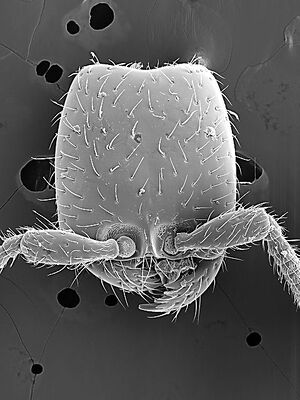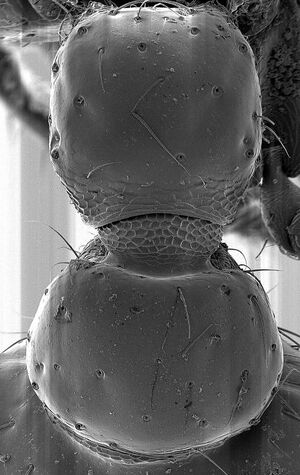Neivamyrmex pauxillus
| Neivamyrmex pauxillus | |
|---|---|

| |
| Scientific classification | |
| Kingdom: | Animalia |
| Phylum: | Arthropoda |
| Class: | Insecta |
| Order: | Hymenoptera |
| Family: | Formicidae |
| Subfamily: | Dorylinae |
| Genus: | Neivamyrmex |
| Species: | N. pauxillus |
| Binomial name | |
| Neivamyrmex pauxillus (Wheeler, W.M., 1903) | |
Because they are rarely encountered, little is known of their habits. Some success has been had locating these minute species using underground baiting. They will likely prove to be subterranean predators of either other ants or of termites. (Snelling and Snelling 2007)
Identification
This is one of several small, nondescript yellow Neivamyrmex species.
Keys including this Species
Distribution
United States: Louisiana and Texas; Mexico: Hidalgo (Watkins, 1982).
Latitudinal Distribution Pattern
Latitudinal Range: 31.633925° to 18.11944°.
| North Temperate |
North Subtropical |
Tropical | South Subtropical |
South Temperate |
- Source: AntMaps
Distribution based on Regional Taxon Lists
Nearctic Region: United States (type locality).
Neotropical Region: Mexico.
Distribution based on AntMaps
Distribution based on AntWeb specimens
Check data from AntWeb
Countries Occupied
| Number of countries occupied by this species based on AntWiki Regional Taxon Lists. In general, fewer countries occupied indicates a narrower range, while more countries indicates a more widespread species. |

|
Estimated Abundance
| Relative abundance based on number of AntMaps records per species (this species within the purple bar). Fewer records (to the left) indicates a less abundant/encountered species while more records (to the right) indicates more abundant/encountered species. |

|
Biology
Wheeler (1904) - Described from nine specimens; the only occasion on which I have seen this species. The insects were moving along under a stone in a small troop, all the members of which were very nearly of the same diminutive size.
Castes
Worker
    
| |
| . | |
Nomenclature
The following information is derived from Barry Bolton's Online Catalogue of the Ants of the World.
- pauxillus. Eciton (Acamatus) pauxillum Wheeler, W.M. 1903b: 93, fig. 1 (w.) U.S.A. (Texas).
- Type-material: 9 syntype workers.
- Type-locality: U.S.A.: Texas, Austin, Paisano Pass, 25.v.1901(W.M. Wheeler).
- Type-depositories: AMNH, MCZC.
- Watkins, 1971: 99 (q.).
- Combination in E. (Neivamyrmex): Smith, M.R. 1942c: 569;
- combination in Neivamyrmex: Borgmeier, 1953: 19.
- Status as species: Wheeler, W.M. 1908e: 412; Emery, 1910b: 25; Wheeler, W.M. 1910g: 562; Smith, M.R. 1938b: 158; Smith, M.R. 1942c: 569 (redescription); Creighton, 1950a: 75; Smith, M.R. 1951a: 781; Borgmeier, 1955: 570 (redescription); Smith, M.R. 1958c: 109; Smith, M.R. 1967: 345; Watkins, 1971: 99 (redescription); Kempf, 1972a: 157; Watkins, 1972: 350 (in key); Watkins, 1976: 18 (in key); Smith, D.R. 1979: 1332; Watkins, 1982: 211 (in key); Watkins, 1985: 483 (in key); Bolton, 1995b: 290; Snelling, G.C. & Snelling, 2007: 488.
- Distribution: Mexico, U.S.A.
Unless otherwise noted the text for the remainder of this section is reported from the publication that includes the original description.
Description
Worker
Length 1.75-2 mm.
Mandibles with a very prominent basal tooth. Head, including mandibles, fully twice as long as broad, occipital border slightly concave, posterior angles rather sharp, sides subparallel. Eyes completely absent. Antennal scape thick, not reaching half way to the posterior angle of the head, funiculus robust, first joint nearly as long as the second and third together, joints 2-6 distinctly broader than long; joints 7-9 about as wide as long. Thorax flattened dorsally, laterally compressed, with distinct mesoepinotal constriction; basal surface of epinotum flattened, longer than the declivity, with which it forms a rounded, obtuse angle. Petiole and postpetiole, whether seen from above or in profile, of similar size and form; each furnished with an anterior ventral tooth; petiole distinctly longer than the postpetiole, longer than broad, subelliptical from above; postpetiole not longer than broad, somewhat wider behind than in front. Gaster elongate elliptical, distinctly flattened dorso-ventrally. Legs short and robust. Claws simple.
Smooth and shining, especially the head and thoracic dorsum; sides of neck, meso- and metapleurae, together with the ventral surfaces of the petiole and postpetiole, distinctly and evenly reticulate. Mandibles, head and thorax with coarse but scattered piligerous punctures.
Body and appendages covered with sparse and rather long, suberect, yellow hairs. Reddish yellow throughout except the mandibles, clypeus, and anterior border of the head which are more brownish.
Type Material
Described from nine specimens taken at Austin, Tex., May 25, 1901.
References
- Borgmeier, T. 1953. Vorarbeiten zu einer Revision der neotropischen Wanderameisen. Stud. Entomol. 2: 1-51 (page 19, Combination in Neivamyrmex)
- Borgmeier, T. 1955. Die Wanderameisen der neotropischen Region. Stud. Entomol. 3: 1-720 (page 570, see also)
- Snelling, G. C.; Snelling, R. R. 2007. New synonymy, new species, new keys to Neivamyrmex army ants of the United States. In Snelling, R. R., B. L. Fisher, and P. S. Ward (eds). Advances in ant systematics (Hymenoptera: Formicidae): homage to E. O. Wilson - 50 years of contributions. Memoirs of the American Entomological Institute 80:459-550. PDF
- Smith, M. R. 1942c. The legionary ants of the United States belonging to Eciton subgenus Neivamyrmex Borgmeier. Am. Midl. Nat. 27: 537-590 (page 569, Combination in E. (Neivamyrmex))
- Varela-Hernández, F., Medel-Zosayas, B., Martínez-Luque, E.O., Jones, R.W., De la Mora, A. 2020. Biodiversity in central Mexico: Assessment of ants in a convergent region. Southwestern Entomologist 454: 673-686.
- Watkins, J. F., II. 1971. A taxonomic review of Neivamyrmex moseri, N. pauxillus, and N. leonardi, including new distribution records and original descriptions of queens of the first two species. J. Kans. Entomol. Soc. 44: 93-103 (page 99, queen described)
- Wheeler, W. M. 1903c. A decad of Texan Formicidae. Psyche (Camb.) 10: 93-111 (page 93, fig. 1 worker described)
References based on Global Ant Biodiversity Informatics
- Borgmeier T. 1955. Die Wanderameisen der neotropischen Region. Studia Entomologica 3: 1-720.
- Cokendolpher J. C., and O. F. Francke. 1990. The ants (Hymenoptera, Formicidae) of western Texas. Part II. Subfamilies Ecitoninae, Ponerinae, Pseudomyrmecinae, Dolichoderinae, and Formicinae. Special Publications, the Museum. Texas Tech University 30:1-76.
- Dash S. T. and L. M. Hooper-Bui. 2008. Species diversity of ants (Hymenoptera: Formicidae) in Louisiana. Conservation Biology and Biodiversity. 101: 1056-1066
- Dattilo W. et al. 2019. MEXICO ANTS: incidence and abundance along the Nearctic-Neotropical interface. Ecology https://doi.org/10.1002/ecy.2944
- Fernandes, P.R. XXXX. Los hormigas del suelo en Mexico: Diversidad, distribucion e importancia (Hymenoptera: Formicidae).
- Kempf, W.W. 1972. Catalago abreviado das formigas da regiao Neotropical (Hym. Formicidae) Studia Entomologica 15(1-4).
- Moser J. C. and M. S. Blum. 1960. The Formicidae of Louisiana. Insect Conditions in Louisiana 3: 48-50
- O'Keefe S. T., J. L. Cook, T. Dudek, D. F. Wunneburger, M. D. Guzman, R. N. Coulson, and S. B. Vinson. 2000. The Distribution of Texas Ants. The Southwestern Entomologist 22: 1-92.
- Quiroz-Robledo, L.N. and J. Valenzuela-Gonzalez. 2006. Las hormigas Ecitoninae (Hymenoptera: Formicidae) de Morelos, México. Revista Biologia Tropical 54(2):531-552
- Rojas Fernandez P. 2010. Capítulo 24. Hormigas (Insecta: Hymenoptera: Formicidae). In: Diversidad Biológica de Veracruz. Volumen Invertebrados. CONABIO-Gobierno del Estado de Veracruz.
- Smith M. R. 1936. A list of the ants of Texas. Journal of the New York Entomological Society 44: 155-170.
- Smith M. R. 1942. The legionary ants of the United States belonging to Eciton subgenus Neivamyrmex Borgmeier. American Midland Naturalist 27: 537-590.
- Snelling G. C. and R. R. Snelling. 2007. New synonymy, new species, new keys to Neivamyrmex army ants of the United States. Memoirs of the American Entomological Institute 80: 459-550
- Vasquez-Bolanos M. 2011. Checklist of the ants (Hymenoptera: Formicidae) from Mexico. Dugesiana 18(1): 95-133.
- Vásquez-Bolaños M. 2011. Lista de especies de hormigas (Hymenoptera: Formicidae) para México. Dugesiana 18: 95-133
- Watkins II, J.F. 1982.The army ants of Mexico (Hymenoptera: Formicidae: Ecitoninae). Journal of the Kansas Entomological Society 55(2): 197-247.
- Watkins J. F., II 1971. A taxonomic review of Neivamyrmex moseri, N. pauxillus, and N. leonardi, including new distribution records and original descriptions of queens of the first two species. Journal of the Kansas Entomological Society 44: 93-103.
- Wheeler W. M. 1903. A decad of Texan Formicidae. Psyche (Cambridge). 10: 93-111.
- Wheeler W. M. 1908. The ants of Texas, New Mexico and Arizona. (Part I.). Bulletin of the American Museum of Natural History 24: 399-485.
- Wheeler, G.C. and J. Wheeler. 1985. A checklist of Texas ants. Prairie Naturalist 17:49-64.

